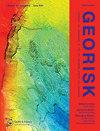Towards an AI-based early warning system for bridge scour
IF 4.8
3区 工程技术
Q1 ENGINEERING, GEOLOGICAL
Georisk-Assessment and Management of Risk for Engineered Systems and Geohazards
Pub Date : 2023-06-26
DOI:10.1080/17499518.2023.2222371
引用次数: 1
Abstract
Scour is the number one cause of bridge failure in many parts of the world. Considering the lack of reliability in existing empirical equations for scour depth estimation and the complexity and uncertainty of scour as a physical phenomenon, it is essential to develop more reliable solutions for scour risk assessment. This study introduces a novel AI approach for early forecast of scour based on real-time monitoring data obtained from sonar and stage sensors installed at bridge piers. Long-short Term Memory networks (LSTMs), a prominent Deep Learning algorithm successfully used for time-series forecasting in other fields, were developed and trained using river stage and bed elevation readings for more than 11 years, obtained from Alaska scour monitoring programme. The capability of the AI models in scour prediction is shown for three case-study bridges. Results show that LSTMs can capture the temporal and seasonal patterns of both flow and river bed variations around bridge piers, through cycles of scour and filling and can provide reasonable predictions of upcoming scour depth as early as seven days in advance. It is expected that the proposed solution can be implemented by transportation authorities for development of emerging AI-based early warning systems, enabling superior bridge scour management.基于人工智能的桥梁冲刷预警系统研究
冲刷是世界上许多地方桥梁破坏的头号原因。考虑到现有的冲刷深度估计经验方程缺乏可靠性,以及冲刷作为一种物理现象的复杂性和不确定性,开发更可靠的冲刷风险评估解是必要的。本文介绍了一种新的人工智能方法,基于安装在桥墩上的声纳和级传感器实时监测数据,对冲刷进行早期预测。长短期记忆网络(LSTMs)是一种杰出的深度学习算法,已成功用于其他领域的时间序列预测,该算法使用阿拉斯加州冲刷监测计划获得的超过11年的河段和河床高程读数进行开发和训练。人工智能模型在三个案例研究桥梁冲刷预测中的能力。结果表明,LSTMs可以通过冲刷和填筑周期捕捉桥墩周围水流和河床变化的时间和季节特征,并可以提前7天对即将到来的冲刷深度进行合理预测。预计该解决方案可以被交通部门用于开发新兴的基于人工智能的预警系统,从而实现更好的桥梁冲刷管理。
本文章由计算机程序翻译,如有差异,请以英文原文为准。
求助全文
约1分钟内获得全文
求助全文
来源期刊
CiteScore
8.70
自引率
10.40%
发文量
31
期刊介绍:
Georisk covers many diversified but interlinked areas of active research and practice, such as geohazards (earthquakes, landslides, avalanches, rockfalls, tsunamis, etc.), safety of engineered systems (dams, buildings, offshore structures, lifelines, etc.), environmental risk, seismic risk, reliability-based design and code calibration, geostatistics, decision analyses, structural reliability, maintenance and life cycle performance, risk and vulnerability, hazard mapping, loss assessment (economic, social, environmental, etc.), GIS databases, remote sensing, and many other related disciplines. The underlying theme is that uncertainties associated with geomaterials (soils, rocks), geologic processes, and possible subsequent treatments, are usually large and complex and these uncertainties play an indispensable role in the risk assessment and management of engineered and natural systems. Significant theoretical and practical challenges remain on quantifying these uncertainties and developing defensible risk management methodologies that are acceptable to decision makers and stakeholders. Many opportunities to leverage on the rapid advancement in Bayesian analysis, machine learning, artificial intelligence, and other data-driven methods also exist, which can greatly enhance our decision-making abilities. The basic goal of this international peer-reviewed journal is to provide a multi-disciplinary scientific forum for cross fertilization of ideas between interested parties working on various aspects of georisk to advance the state-of-the-art and the state-of-the-practice.

 求助内容:
求助内容: 应助结果提醒方式:
应助结果提醒方式:


